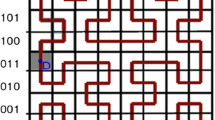Abstract
This paper presents a framework for resource management in highly dynamic active networks. The goal is to allocate and manage node resources in an efficient way while ensuring effective utilization of network and supporting load balancing. The framework supports co-existence of active and non-active nodes and proposes a novel Directory Service (DS) architecture that can be used to discover the suitable active nodes in the Internet and for selecting the best network path (end-to-end) and reserving the resources along the selected path. Intranode and internode resource management are facilitated through the DS, while within an active node the framework implements a composite scheduling scheme to schedule both the CPU and bandwidth resources to resolve the combined resource scheduling problems. In addition, a flexible active node database system and a simple adaptive prediction technique have been introduced in order to resolve the challenging problem of determining the CPU requirements of the incoming packets.
Similar content being viewed by others
References
D.S. Alexander, W.A. Arbaugh, A.D. Keromytis and J.M. Smith, A secure active network environment architecture: Realization in switchware, Special Issue on Active and Programmable Networks of IEEE Network Magazine 12(3) (1998) 37–45.
J.C.R. Bennett and H. Zhang, WFQ: Worst-case fair weighted fair queueing, in: Proc. of the IEEE INFOCOM, San Francisco, March 1996.
K. Calvert, S. Bhattacharjee, E. Zegura and J. Sterbenz, Direction in active networks, IEEE Communication Magazine 36(10) (1998) 72–78.
A. Campbell, H.G. De Meer and M.E. Kounavis, A survey of programmable networks, Center for Telecommunication Research, Columbia University, ACM SIGGCOMM Comp. Commun. Rev. (April 1999).
A. Demers, S. Keshav and S. Shenker, Analysis and simulation of a fair queueing algorithm, in: SIGCOMM '89, 1989.
A. Fernando and B. Kummerfeld, PANTS: Python active node transfer system, Technical Report, University of Sydney, Australia (1998).
Z. Fu and N. Venkatasubramanian, Directory-based composite routing and scheduling policies for dynamic multimedia environments, in: Proc. of the IEEE Internat. Parallel and Distributed Processing Symposium 2001 (IPDPS 2001).
V. Galtier, K. Mills and Y. Carlinet, Predicting and controlling resource usage in a heterogeneous active network, National Institute of Standards (2001).
P. Goyal, H.M. Vin and H. Cheng, Start-time fair queueing: A scheduling algorithm for integrated services packet switching networks, IEEE/ACM Transactions on Networking 5(5) (1997) 690–704.
S.K. Jha, P.A. Wright and M. Fry, Playout management of interactive video-an adaptive approach, in: Proc. of the 5th Internat. Workshop on Quality of Service (IWQOS '97), Columbia University, New York, 1997, pp. 145–156.
D. Kiwior and S. Zabele, Active resource allocation in active networks, IEEE Journal on Selected Areas in Communications 19(3) (2001) 452–459.
K. Najafi, Modelling, routing and architecture in active networks, Ph.D. thesis, Department of Electrical and Computer Engineering, University of Toronto (2001).
NS2 simulator, The LBLN network simulator, University of California, Berkley, USA.
P. Pappu and T. Wolf, Scheduling processing resources in programmable routers, Department of Computer Science, Washington University in St. Louis, MO, WUCS-01-32 (25 July 2001).
A.K. Parekh and R.G. Gallagher, A generalized processor sharing approach in integrated services networks, in: INFOCOMM '93, 1993.
X. Qie, A. Bavier, L. Peterson and S. Karlin, Scheduling computations on a software-based router, in: Proc. of the IEEE Joint Internat. Conf. on Measurement & Modeling of Computer Systems (SIGMETRICS), Cambridge, MA, June 2001 (IEEE Press, New York).
V. Ramachandran and R. Pandey, Resource allocation in active networks, Technical Report TR-99-10, Parallel and Distributed Computing Laboratory, Computer Science Department, University of California, Davis, CA (28 August 2000).
V. Ramachandran, R. Pandey and S.-H. Chan, Fair resource allocation in active networks, in: Proc. of the IEEE Internat. Conf. on Computer Communications and Networks (ICCCN), Las Vegas, NV, 16-18 October 2000, pp. 468–475.
F. Sabrina and S. Jha, A novel architecture for resource management for active networks using a directory service, in: Proc. ICT 2003, Papeete, French Polynesia, February 2003, pp. 45–52.
M. Shreedhar and G. Varghese, Efficient fair queueing using deficit round robin, in: SIGCOMM '95, August 1995.
I. Stoica, S. Shenker and H. Zhang, Core-stateless fair queuen: A scalable architecture to approximate fair bandwidth allocations in high speed networks, in: SIGCOMM '98, 1998.
D. Tenenhouse, J.M. Smith, W.D. Sincoskie, D.J. Wetherall and G.J. Minden, A survey of active network research, IEEE Communications Magazine 35(1) (January 1997) 80–86.
D.J. Wetherall, Service introduction in an active networks, Ph.D. thesis, MIT (February 1999).
D. Wetherall, J. Guttang and D. Tenenhousr, ANTS: A toolkit for building and dynamically deploying network protocols, in: IEEE OPENARCH '98, San Fransisco, CA, April 1998.
D. Wetherall, U. Legedza and J. Guttang, Introducing new internet services: Why and how, IEEE Network Magazine 12(3) (1998) 12–19.
Author information
Authors and Affiliations
Rights and permissions
About this article
Cite this article
Sabrina, F., Jha, S. An Adaptive Resource Management Architecture for Active Networks. Telecommunication Systems 24, 139–166 (2003). https://doi.org/10.1023/A:1026110728678
Issue Date:
DOI: https://doi.org/10.1023/A:1026110728678




